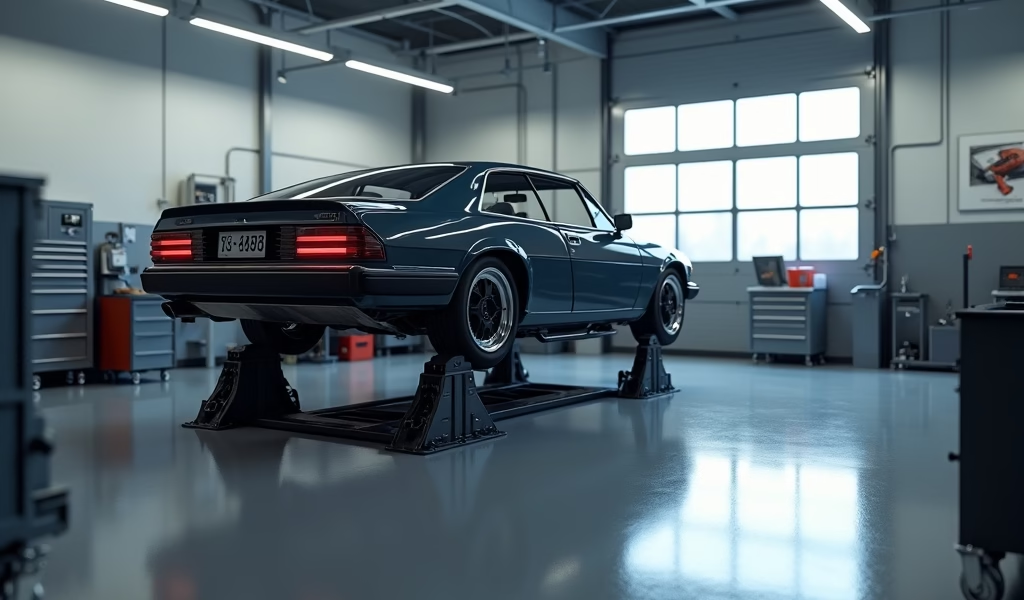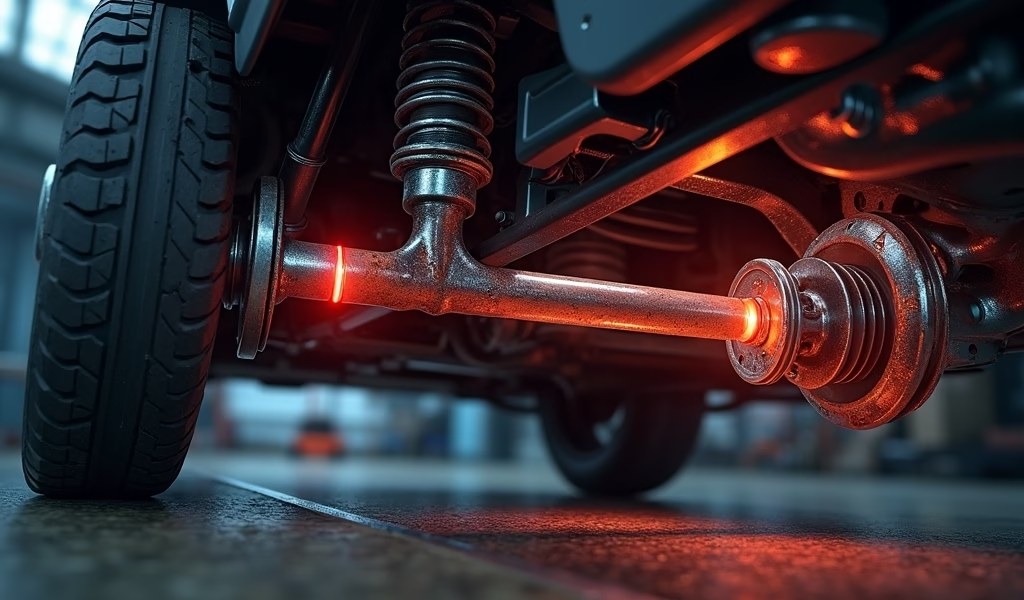Overview
This article provides a detailed 5-step driveshaft balancing procedure to diagnose and resolve vehicle vibration issues, covering everything from the signs of an unbalanced driveshaft to the tools needed and common mistakes to avoid. Proper driveshaft balancing is essential for vehicle performance and longevity, helping to prevent premature wear of components and ensuring smooth, vibration-free driving at all speeds.
Updated October 2023 – Looking for a comprehensive guide on driveshaft balancing procedures? You’ve come to the right place. This detailed walkthrough covers everything you need to know about properly balancing a driveshaft, from diagnosis to implementation. Whether you’re experiencing vibrations at highway speeds or just performing preventive maintenance, understanding the proper driveshaft balancing procedure is essential for your vehicle’s performance and longevity.
Table of Contents
- Understanding Driveshaft Balancing: Why It Matters
- 5 Telltale Signs Your Driveshaft Needs Balancing
- Essential Tools for Proper Driveshaft Balancing
- Preparation: Getting Your Vehicle Ready
- The 5-Step Driveshaft Balancing Procedure
- Common Mistakes to Avoid During Driveshaft Balancing
- Post-Balancing Tests: Ensuring Success
- Conclusion: Maintaining Your Balanced Driveshaft
- Frequently Asked Questions
- Sources
Understanding Driveshaft Balancing: Why It Matters
Your vehicle’s driveshaft is a critical component that transfers power from the transmission to the differential, ultimately rotating your wheels. When it’s properly balanced, you’ll experience smooth driving with minimal vibration. But when balance issues occur (and they inevitably do, over time), the results can range from annoying to downright dangerous.
A balanced driveshaft ensures even weight distribution around its axis of rotation. Think of it like a perfectly balanced tire – without proper balancing, you’ll feel vibrations, hear unusual noises, and potentially cause premature wear to other vehicle components. In extreme cases, an unbalanced driveshaft can even break, leading to costly repairs and safety hazards.
The balancing procedure isn’t just about adding weights (though that’s part of it). It’s a precise process that requires attention to detail, proper tools, and a methodical approach. And while professional shops have specialized equipment for this task, understanding the procedure will help you communicate better with your mechanic or even tackle it yourself if you’re mechanically inclined.
5 Telltale Signs Your Driveshaft Needs Balancing
Before diving into the balancing procedure, let’s identify the symptoms that suggest your driveshaft needs attention. Catching these early can save you from more extensive damage down the road (literally!).
First and most common is vibration that increases with speed. If you notice your vehicle vibrating more intensely as you accelerate, particularly around 45-55 mph, your driveshaft might be the culprit. This vibration often feels different from tire balance issues – it typically resonates through the floorboards rather than the steering wheel.
Second, pay attention to unusual noises. A clunking or knocking sound, especially during acceleration or deceleration, often indicates driveshaft universal joint problems or balance issues.
Third, watch for increased vibration during acceleration. If the vibration intensifies specifically when you press the gas pedal, that’s a strong indicator of driveshaft issues rather than wheel balancing problems.
Fourth, notice if the vibration changes when coasting versus under power. Driveshaft balance issues often manifest differently depending on whether you’re accelerating or coasting in neutral.
Finally, look for signs of wear on other components. An unbalanced driveshaft puts strain on your transmission, differential, and axle shaft splines, potentially causing premature wear.

Essential Tools for Proper Driveshaft Balancing
Balancing a driveshaft requires specific tools – attempting the job without them is like trying to change a tire without a jack. Let’s review what you’ll need:
- Dial indicator with magnetic base (for measuring runout)
- Jack and jack stands (for safely elevating the vehicle)
- Wheel chocks (for additional safety)
- Chalk or marker (for marking reference points)
- Balancing weights (typically hose clamps or purpose-made weights)
- Torque wrench (for proper reinstallation)
- Socket set and wrenches (for removal and installation)
- Safety glasses and gloves (because safety first, folks!)
- Shop towels and degreaser (for cleaning)
If you’re tackling this at home rather than using a professional balancing machine, you’ll also need a helper to assist with the test drive portion of the diagnosis. And patience – you’ll definitely need plenty of that!
For those wanting absolute precision, investing in or renting a strobe balancer can make the job more accurate. These devices measure vibration frequencies and help pinpoint imbalance locations more precisely than the trial-and-error method we’ll describe.
Preparation: Getting Your Vehicle Ready
Proper preparation is half the battle in successful driveshaft balancing. Start by ensuring your vehicle is on level ground – your driveway might seem flat, but even slight inclines can affect balancing accuracy. A garage floor or level parking area is ideal.
Next, secure the vehicle properly. Apply the parking brake and chock the front wheels (assuming you’re working on a rear-wheel or all-wheel drive vehicle). Safety should always be your priority when working underneath any vehicle.
Before jacking up the vehicle, take it for a test drive to accurately diagnose the symptoms. Pay close attention to the speeds at which vibration occurs, whether it changes with acceleration or deceleration, and any accompanying noises. This information will be valuable later when verifying your balancing has resolved the issue.
Once the vehicle is safely elevated on jack stands (never rely solely on a jack!), visually inspect the entire driveshaft assembly. Look for obvious damage, missing balance weights, or signs of impact. Check the universal joints for excessive play by trying to move the shaft in different directions. Worn joints can cause vibrations that mimic balance issues but won’t be resolved through balancing alone.
Finally, clean the driveshaft thoroughly. Road grime, mud, or undercoating can add uneven weight and affect balancing accuracy. A clean driveshaft also makes it easier to spot existing balance weights or marks from previous balancing attempts.
The 5-Step Driveshaft Balancing Procedure
Now for the main event – the actual balancing procedure. I’ll break this down into five clear steps that, when followed carefully, should result in a properly balanced driveshaft.
Step 1: Initial Inspection and Runout Measurement
With the vehicle securely raised, rotate the driveshaft by hand and observe its movement. It should rotate smoothly without binding. Next, set up your dial indicator to measure runout – this is the deviation from perfect straightness as the shaft rotates.
Position the dial indicator’s tip against the driveshaft at its center (or at multiple points along longer shafts). Zero the gauge, then rotate the shaft slowly and record the maximum reading. For most passenger vehicles, runout shouldn’t exceed 0.010 inches (0.25mm). Greater runout might indicate a bent shaft that needs replacement rather than balancing.
While performing this inspection, check for any obvious physical damage or missing balance weights. Sometimes the solution is as simple as replacing a weight that has fallen off.
Step 2: Mark Your Reference Points
Using chalk or a marker, create reference marks at several points around the circumference of the driveshaft. I typically recommend marking at the 12, 3, 6, and 9 o’clock positions. These marks will help you track rotation and make consistent adjustments.
Also create a longitudinal mark along the length of the shaft. This helps ensure you’re installing any weights at the correct location along the shaft’s length. Remember, driveshaft balance is three-dimensional – the weight placement matters both around the circumference and along the length.
Step 3: Initial Test Drive and Vibration Assessment
This is where having a helper becomes valuable. Lower the vehicle, remove the jack stands, and take a test drive. Pay careful attention to the speeds at which vibration occurs most severely. Most driveshaft vibrations are most noticeable in a specific speed range, often between 45-65 mph.
If possible, have your helper observe the driveshaft while you drive at the problem speed (this requires special inspection pits or lifts with appropriate safety measures – don’t improvise unsafe viewing methods!). Professional shops use strobe lights to “freeze” the driveshaft’s motion and identify the heavy spot, but for DIY balancing, we’ll rely on the trial-and-error method in the next steps.
Step 4: Adding Test Weights
After identifying the problem speed range, it’s time to add test weights. Hose clamps make excellent temporary balancing weights – they can be easily repositioned and provide adjustable weight depending on size.
Start by adding a small weight (like a 2-inch hose clamp) at one of your reference marks. Take another test drive at the problem speed and note whether the vibration improves or worsens. If it worsens, move the weight to the opposite side (180 degrees around) and test again. If it improves but doesn’t eliminate the vibration, try adding slightly more weight in the same position or experimenting with positions 90 degrees away.
This process requires patience and methodical testing. Keep detailed notes about weight positions and the resulting vibration changes. Through this process of elimination, you’ll eventually find the optimal weight position that minimizes vibration.
Step 5: Permanent Weight Installation
Once you’ve determined the ideal weight position, it’s time to install permanent weights. For DIY applications, hose clamps can serve as permanent weights, but purpose-made balance weights provide more precise control. Some mechanics weld small weights to the driveshaft, but this should only be done by experienced professionals as welding can introduce heat distortion.
After installing permanent weights, take a final test drive through various speeds to verify the vibration is eliminated. Pay particular attention to acceleration, deceleration, and steady cruising at the previously problematic speeds.
Remember that proper CV joint angles are crucial for driveshaft operation, so ensure your balancing weights don’t interfere with the normal range of motion of joints or create clearance issues with other components.

Common Mistakes to Avoid During Driveshaft Balancing
Even experienced mechanics can make errors during driveshaft balancing. Here are some common pitfalls to avoid:
First, don’t confuse driveshaft vibrations with other issues. Tire balance problems, wheel bearing wear, or engine mounts can all create vibrations that might seem like driveshaft issues. Proper diagnosis is critical before you start adding weights to your driveshaft.
Second, avoid using too much weight. A properly designed driveshaft shouldn’t need excessive balancing weight. If you find yourself adding numerous heavy weights, there might be a more fundamental problem like a bent shaft or damaged universal joint.
Third, don’t neglect to check for loose components. Sometimes what feels like a balance issue is simply loose U-joint straps, transmission mounts, or differential mounting bolts. These should be verified before attempting balancing.
Fourth, beware of uneven weight distribution. Adding weights to only one spot can sometimes create more problems than it solves. Professional balancing often involves multiple smaller weights rather than one large one.
Finally, don’t forget to recheck all fasteners after the procedure. Driveshaft bolts should be torqued to manufacturer specifications – too tight can damage components, while too loose can create dangerous conditions.
Post-Balancing Tests: Ensuring Success
After completing the balancing procedure, thorough testing is essential to confirm success. Begin with low-speed driving, gradually increasing to highway speeds while paying attention to any remaining vibrations.
Test under various conditions: acceleration, steady speed, deceleration, and coasting. Driveshaft vibrations can manifest differently under different load conditions, so be thorough in your testing.
Also perform what mechanics call a “coast-down test.” Accelerate to highway speed, then shift to neutral and coast down through various speed ranges. This removes power train influence and can help identify any remaining balance issues.
Listen carefully for any unusual noises that might indicate a loose balancing weight or other issues. A properly balanced driveshaft should operate silently and without vibration at all normal operating speeds.
After approximately 100 miles of driving, recheck all weights and fasteners to ensure nothing has shifted or loosened. This follow-up check can prevent future problems and confirm your balancing procedure was successful.
Conclusion: Maintaining Your Balanced Driveshaft
A properly balanced driveshaft contributes significantly to your vehicle’s comfort, performance, and longevity. By following the five-step procedure outlined above, you can diagnose and address balance issues before they cause more serious damage.
Remember that driveshaft balancing is both science and art – it requires precision measurements combined with careful testing and adjustment. Don’t hesitate to seek professional help if you’re uncertain about any aspect of the procedure.
Regular maintenance inspections should include a visual check of your driveshaft and its balancing weights. Early intervention at the first sign of vibration can prevent more costly repairs down the road.
Keep in mind that changes to your vehicle – like suspension lifts, tire size changes, or drivetrain modifications – can affect driveshaft angles and potentially require rebalancing. If you modify your vehicle, include driveshaft evaluation as part of your overall upgrade plan.
With proper attention to detail and regular maintenance, your vehicle’s driveshaft should provide thousands of miles of smooth, vibration-free operation. The effort you invest in proper balancing pays dividends in ride comfort, component longevity, and driving enjoyment.
Frequently Asked Questions
How much does professional driveshaft balancing typically cost?
Professional driveshaft balancing usually costs between $100-$200, depending on your location and vehicle type. This price typically includes removal, balancing, and reinstallation.
How often should a driveshaft be balanced?
Driveshafts generally don’t require regular balancing unless you notice vibration symptoms. They should be checked after suspension modifications or if vibration develops.
Can I drive with an unbalanced driveshaft?
While technically possible, driving with an unbalanced driveshaft isn’t recommended. It can damage other components and potentially lead to catastrophic driveshaft failure.
What’s the difference between static and dynamic driveshaft balancing?
Static balancing addresses weight distribution around the circumference, while dynamic balancing also corrects for weight distribution along the shaft’s length. Professional shops typically perform dynamic balancing for best results.
Will new U-joints fix my driveshaft vibration?
Sometimes yes, if worn U-joints are causing the vibration. However, even new U-joints won’t fix an inherently unbalanced driveshaft.
Can driveshaft balancing eliminate all vehicle vibrations?
No, driveshaft balancing only addresses vibrations caused by the driveshaft itself. Tires, wheels, engine, and suspension components can all cause different types of vibrations.
Is balancing necessary after driveshaft repair?
Yes, any time a driveshaft is disassembled, repaired, or has components replaced, it should be rebalanced. The repair process often changes the weight distribution.
Can I balance a two-piece driveshaft using the same procedure?
Two-piece driveshafts require each section to be balanced individually, then as an assembly. This is typically best left to professional shops with specialized equipment.
Why did my balancing weights fall off?
Balancing weights can fall off due to improper installation, road debris impacts, or corrosion. Using high-quality weights and proper installation techniques helps prevent this issue.
Is driveshaft balancing a permanent fix?
A properly balanced driveshaft should remain balanced for the life of the components. However, impacts, component wear, or corrosion can eventually necessitate rebalancing.
Sources
Our comprehensive guide is backed by expert knowledge and trusted resources in the automotive industry. We’ve consulted the following authoritative sources to ensure accuracy:
Spicer Driveshaft Technical Service Manual – Industry-standard guidelines for driveshaft maintenance and balancing procedures.
Society of Automotive Engineers (SAE) Technical Paper – Research on driveline vibration diagnosis and resolution methods.
Motor Trend Technical Articles – Professional insights on driveshaft maintenance and balancing techniques.
Ready to eliminate those annoying driveshaft vibrations once and for all? Our certified mechanics specialize in driveshaft diagnosis, balancing, and repair. Book your appointment today and enjoy 15% off your first driveshaft service when you mention code “SMOOTHDRIVE” online or in-store. Don’t let vibrations ruin your driving experience—contact us now for professional driveshaft balancing that’s guaranteed to restore your vehicle’s smooth performance!

